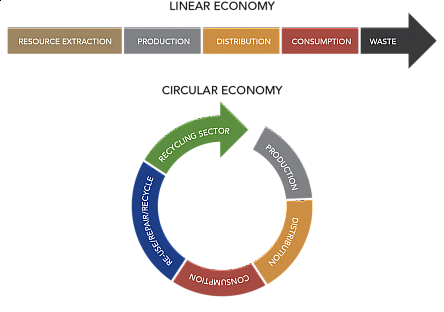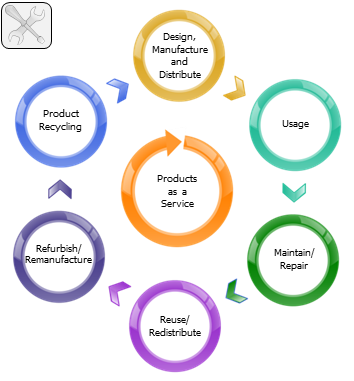May 12, 2015
There is a lot of discussion these days about the “circular economy”—a new environmental paradigm if you will. According to Wikipedia, the circular economy is “a generic term for an industrial economy that is, by design or intention, restorative and in which material flows are of two types, biological nutrients, designed to reenter the biosphere safely, and technical nutrients, which are designed to circulate at high quality without entering the biosphere.”
 In a nutshell, advocates of a circular economy promote the move from our current linear economy of “take, make, waste” toward a nonlinear, feedback or “closed-loop” oriented one. Such an economy would focus on systems and embrace the concepts of cradle to cradle, biomimicry, and industrial ecology. It necessitates a change in our current systems of production and consumption of goods and services, embracing more productive and resilient systems and a shift from fossil fuels toward the use of renewable energy.
In a nutshell, advocates of a circular economy promote the move from our current linear economy of “take, make, waste” toward a nonlinear, feedback or “closed-loop” oriented one. Such an economy would focus on systems and embrace the concepts of cradle to cradle, biomimicry, and industrial ecology. It necessitates a change in our current systems of production and consumption of goods and services, embracing more productive and resilient systems and a shift from fossil fuels toward the use of renewable energy.
The circular economy would move us away from our current industrial model which uses finite resources in the manufacture of goods, which are then consumed, and then disposed. In our existing economy we focus largely on recycling packaging; however, the products in the packaging,from electronics to blenders, are often not recycled. More importantly, the design and manufacture of our consumer products embraces embedded obsolescence. Repair, once a mainstay of our economy, has become more expensive than disposal and product replacement. While plastics serve many benefits, including light-weighting and making product manufacturing less expensive (in a purely economic sense), they are still derived from a nonrenewable resource, and make repair of products less possible and recycling more difficult.
 In the circular economy, we would design out material leakage—the inefficient use of resources and frequent loss of resources through disposal and generation of pollution externalities into the environment, with a goal of a production system that embraces the most efficient use possible of materials and resources. More efficient use of resources in production, designing for durability and repair, and designing for increased recycling will be integral to the circular economy. It will necessitate that producers embrace their role in designing for post-consumer recovery and the recovery of all resources for use in manufacturing new products.
In the circular economy, we would design out material leakage—the inefficient use of resources and frequent loss of resources through disposal and generation of pollution externalities into the environment, with a goal of a production system that embraces the most efficient use possible of materials and resources. More efficient use of resources in production, designing for durability and repair, and designing for increased recycling will be integral to the circular economy. It will necessitate that producers embrace their role in designing for post-consumer recovery and the recovery of all resources for use in manufacturing new products.
As cited by Nina Goodrich, Executive Director of GreenBlue, at NERC’s recent spring conference, “For every 1% increase in GDP, resource use has risen 0.4%” Yes, companies around the world are embracing sustainable decision-making, although their actions do not always reflect their words. Moreover, in our present economic model, it makes sense that Wal-Mart is noted for its “sustainability.” However, in the long-run, Wal-Mart’s very model of providing all of us with an ever increasing number of cheap, non-repairable goods and clothing is not inherently sustainable.
Yes, there have been advances in resource efficiency throughout our manufacturing sector, and yes, many of our products, including electronics and automobiles, are recycled. However, in the long run, is an ever growing economy and GDP sustainable? Can technology itself save us from climate change, ocean acidification, and resource scarcity?
In a world of increasing resource scarcity, volatile commodity prices and economies, and a changing worldwide marketplace that includes a growing middle class and ever increasing consumption, it seems prudent to examine our current economic model. Citizens in China and other developing nations have as much right as we do to feed their desire for consumer goods, diets rich in meat, and other benefits that we enjoy in this country. Ultimately, how long can this be sustained in a “take, make, waste” world?
By Athena Lee Bradley
Photo Credits: Image 1 – http://www.metrovancouver.org; Image 2 - http://circulareconomytoolkit.org/Toolkit.html


Comments (0)
Add a Comment